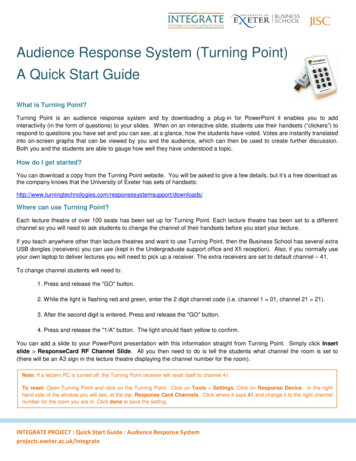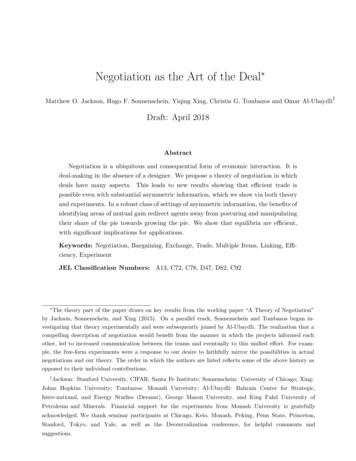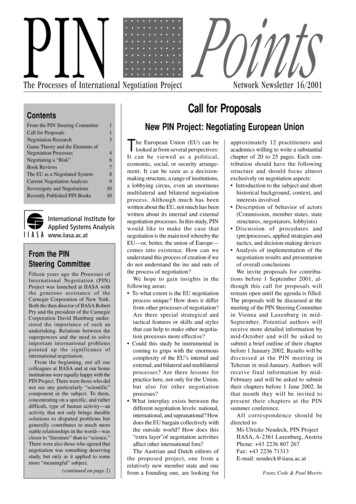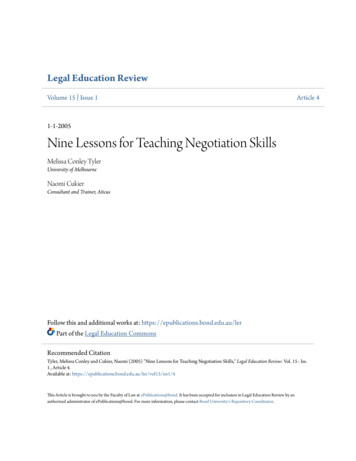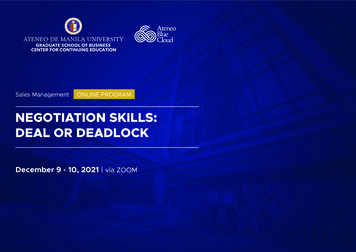
Transcription
Turning Negotiation Into ACorporate CapabilityDanny ErtelSandique , VictorVelasco, Rudolph
Many companies view each negotiation as aseparate situations. But companies that takemore coordinated approach are making betterdeals and forging relationships.
Four Broad Changes in Practice inPerspective Build your firm’s negotiationcapability by:– Creating a negotiation infrastructure.– Broadening your measures ofsuccess.– Distinguishing between the deal andthe relationship.– Learning to walk away from the deal.
Four Broad Changes in Practice inPerspective Build your firm’s negotiationcapability by:– Creating a negotiation infrastructure.One negotiation’s outcome shouldnot hinge solely on an individualnegotiator's skills.Instead, give all negotiators betterand more information, including lessonsfrom past negotiations and corporatepriorities.
Four Broad Changes in Practice inPerspective Build your firm’s negotiation capability by:– Creating a negotiation infrastructure.Steps in theNegotiation ProcessSituational ViewInstitutional ViewExamples of Tools andProceduresDeterminingObjectives Case-to-case basis Negotiators seek tomaximize personalcompensation Larger CorporateGoals Separate goals areestablished for thedeal and therelationship Deal andrelationshipscorecards NegotiationinstructiontemplatePreparing for thenegotiation Proceed in an ad hocmanner Often there is no timefor preparation Preparations arewell structured Negotiators drawon prior corporateexperience Database of pastnegotiations Manager’schecklist for BATNAreview
Four Broad Changes in Practice inPerspective Build your firm’s negotiation capability by:– Creating a negotiation infrastructure.Steps in theNegotiation ProcessConducting theNegotiationSituational ViewInstitutional ViewExamples of Tools andProcedures Negotiators act as lonewolves with littlesupervision Success or failure isseen to depend onpersonal ability Managers play anactive coachingrole Colleagues share anegotiationsapproach andvocabulary Training programsfor negotiators andtheir managers “Yellow Pages” thatenable efficientconsultation withexperiencedcolleagues
Four Broad Changes in Practice inPerspective Build your firm’s negotiation capability by:– Creating a negotiation infrastructure.Steps in theNegotiation ProcessReviewing thenegotiationSituational View Reviews are donesporadically Focus is on costreductions andpercentage of dealsclosedInstitutional ViewExamples of Tools andProcedures Reviews are Structured reviewperformedquestions thatsystematically tofocus not only oncaptureoutcomes but alsoinformation so iton the processcan be applied to Debriefing formsfuture negotiationsthat feed into best Focus in not only inpractices databasethe results but the Training inway it wasconstructiveconducteddebriefing. Reviews extractlessons rather than
Four Broad Changes in Practice inPerspective Build your firm’s negotiationcapability by:– Broadening your measures ofsuccess.Don’t judge negotiations only byfinancial measures. Evaluate other keybenefitsaswell–egbettercommunications with suppliers, freshersolutionsandmoreworkablecommitments. Then, explicitly link thosemeasures to negotiators’ incentives.
Four Broad Changes in Practice inPerspective Build your firm’s negotiation capability by:– Broadening your measures of success.A NEW SET OF MEASURESRELATIONSHIPDoes the negotiation process help build the kind of relationship that willenable us and our clients to work effectively together over the project’s lifecycle?COMMUNICATIONDo our negotiations help create an environment in which both parties canengage in constructive conversations aimed at solving problems?INTERESTSHave we crafted a deal that satisfies our interests well at the same timethat it satisfies our client’s interest to at least an acceptable level and theinterest of any relevant third parties (government regulators,environmental groups etc) to at least a tolerable level.OPTIONSAs part of the negotiation process, have we searched for innovative,elegant and efficient solutions that might offer joint gains
Four Broad Changes in Practice inPerspective Build your firm’s negotiation capability by:– Broadening your measures of success.A NEW SET OF MEASURESLEGITIMACYAfter brainstorming a variety of options, have we used objective criteria toevaluate and choose an option that could be justified by both sides?BATNAHave we measured the proposed deal against our BATNA and we areconfident that it satisfies our interests better than our BATNA does?COMMITMENTHave we generated a set of well planned, realistic and workablecommitments that both sides understand and are prepared to implement?
Distinguishing between the DEAL and the RELATIONSHIP Broadening Performance Measureshas the effect of engendering thedichotomy between a one-off deal andthe whole client-seller relationship
Distinguishing between the DEAL and the RELATIONSHIP Pitfalls of the Deal – Relationship Tightrope Pushing hard on the DEAL jeopardizes the company’s ability to do business with theother party Paying too much attention on RELATIONSHIP may mean giving in too much and endingup with a lousy deal.
Distinguishing between the DEAL and the RELATIONSHIP Deal – Relationship Cycle Traditional ApproachConfirmSuspicions andPerceptions
Distinguishing between the DEAL and the RELATIONSHIP Deal – Relationship Cycle A Better ApproachImprove MutualUnderstanding
Distinguishing between the DEAL and the RELATIONSHIP Kodak and IBM Kodak wanted to reduce cost, IBM wanted to increase revenues Both recognized that the goal is to have a healthy long-term RELATIONSHIP Developed a list of DEAL ISSUES and RELATIONSHIP ISSUES Agreed that any problem from issues arising on one list could not be resolved byexacting concessions on issues from the other list
Deal Issues Retirement and Replacement of HardwareUse of Third Party SoftwareService LevelsEase of CommunicationRecord Storage, Maintenance and SecurityPricingTerms of Employee TransfersTermination and Return of Data CenterOperations to Kodak or Transfer to Another Party Relationship IssuesReliabilityGiving Each Other the Benefit of the DoubtAbsence of CoercionUnderstanding each other’s ObjectivesTimeliness of ConsultationsMutual Respect
Learning to WALKAWAY from a DEAL NEVER-LOSE-A-CLIENT CULTURE
Learning to WALKAWAY from a DEAL The Context Investment of Preparation Investment of Time Investment of Financial Resources The Curse It puts the negotiator in a bind It pushes the negotiator to accept the lowest deal just tocompensate for lost resources.
Learning to WALKAWAY from a DEAL The Challenge Negotiators should know their BATNA - what is BATNA?
Learning to WALKAWAY from a DEAL BATNA Best Alternative To Negotiated Agreement A term coined by Fisher and Ury in their 1981 bestseller, Gettingto Yes: Negotiating Without Giving In The alternative action that will be taken should your proposedagreement with another party result in an unsatisfactoryagreement or when an agreement fails to materialize
Learning to WALKAWAY from a DEAL BATNA In short, BATNA is your walk-away position Anything that is less than your BATNA is ROBNI ReplacementOfferButNotInteresting Burgess and Burgess have EATNA (estimated alt)
Learning to WALKAWAY from a DEAL Tips and Tricks Always define the best alternatives to closing a deal Think them through before you begin negotiating Carefully evaluate the proposed negotiation against the bestalternative If the alternative is better, walk away
Best Alternative To Negotiated Agreement A term coined by Fisher and Ury in their 1981 bestseller, Getting to Yes: Negotiating Without Giving In The alternative action that will be taken should your proposed agreement with another party result in an unsatisfactory agreement or when an agreement fails to materialize





